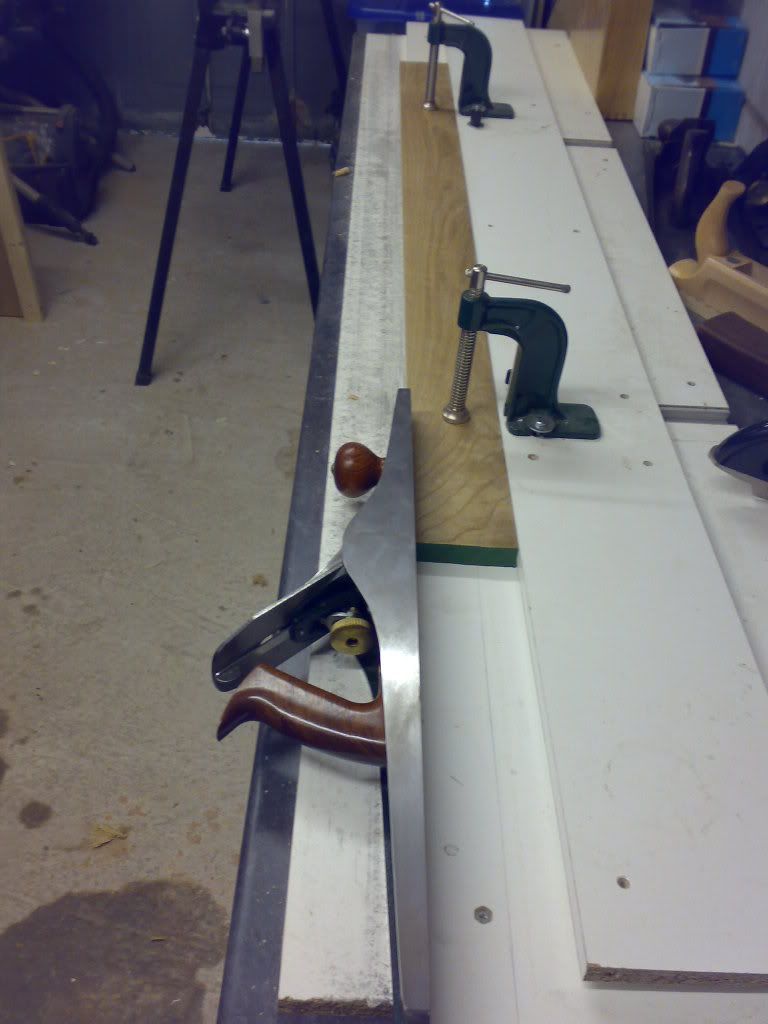dunbarhamlin
Established Member
Following on from the #7 threads, I'd like to learn the various techniques for truing a board edge, so I can make an informed choice as to which to use and when.
The methods I am aware of are:
1. Jigged - shooting board bed and track tuned parallel and out of wind with a straight blade, set square (or, alternatively, shooting board surfaces tuned with a consistant offset angle along their length, and blade adjusted laterally to compensate.)
(1b. fenced planes - jointer fence, or edging planes (yes, I know these are really for planing angles, but a right angle is an angle))
2. Straight blade with offset blade - using lateral adjuster, first locally to remove any wind, then to bring the whole edge true.
(2a: Match planing - this is jointing, doesn't (necessarily) true the edges, just makes them complementary))
And those I don't use yet:
3. Cambered blade - move plane laterally to take thicker shaving from high edge.
Understand this, I think - lots of good info available from Mr C et al. Just need to try (ahem) it.
4. Lateral pressure - straight blade, apply weight to the side that needs the heavier cut.
Hmmm, want to give this a try, but - could anyone give pointers? For instance:
? Given that I'm a fixed weight (well, OK, it's seasonally variable), is a shorter (jack? shorter?) plane better suited for this technique?
? How is the pressure best applied? My guess would be pushing down hard with the left hand thumb, moving it to one side or the other in front of the mouth. But what about the right hand - should that just drive forwards, or also torque the plane?
? What about stance? Inclination (ahem) says lean to the side of the heavy cut, rather than balanced.
? What else haven't I thought of, that may help get this technique off pat (or any of you, for that matter
Thank
Steve
The methods I am aware of are:
1. Jigged - shooting board bed and track tuned parallel and out of wind with a straight blade, set square (or, alternatively, shooting board surfaces tuned with a consistant offset angle along their length, and blade adjusted laterally to compensate.)
(1b. fenced planes - jointer fence, or edging planes (yes, I know these are really for planing angles, but a right angle is an angle))
2. Straight blade with offset blade - using lateral adjuster, first locally to remove any wind, then to bring the whole edge true.
(2a: Match planing - this is jointing, doesn't (necessarily) true the edges, just makes them complementary))
And those I don't use yet:
3. Cambered blade - move plane laterally to take thicker shaving from high edge.
Understand this, I think - lots of good info available from Mr C et al. Just need to try (ahem) it.
4. Lateral pressure - straight blade, apply weight to the side that needs the heavier cut.
Hmmm, want to give this a try, but - could anyone give pointers? For instance:
? Given that I'm a fixed weight (well, OK, it's seasonally variable), is a shorter (jack? shorter?) plane better suited for this technique?
? How is the pressure best applied? My guess would be pushing down hard with the left hand thumb, moving it to one side or the other in front of the mouth. But what about the right hand - should that just drive forwards, or also torque the plane?
? What about stance? Inclination (ahem) says lean to the side of the heavy cut, rather than balanced.
? What else haven't I thought of, that may help get this technique off pat (or any of you, for that matter
Thank
Steve





